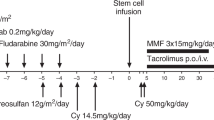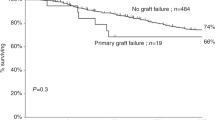Summary:
Conditioning including total body/lymphoid irradiation is widely used to prevent graft rejection in patients with refractory severe aplastic anemia (SAA) undergoing hemopoietic cell transplantation (HCT) from alternative donors and or after graft manipulation. To reduce regimen-related toxicity we transplanted three children with refractory SAA after conditioning with radiotherapy-free regimens. Conditioning included fludarabine 175–180 mg/m2 in all patients. In addition, patient 1 (failing two previous grafts) received thiotepa 10 mg/kg and Campath-1H 60 mg/m2; patient 2 cyclophosphamide 120 mg/kg, thiotepa 15 mg/kg and OKT-3 0.1 mg/kg/day for 4 weeks; and patient 3 cyclophosphamide 120 and ATG 90 mg/kg. Stem cell source was unmanipulated marrow from the same unrelated donor as for the two previous transplantations in patient 1 and CD34+-purified peripheral blood stem cells from an HLA-matched unrelated donor and from the haploidentical mother in patients 2 and 3. Only patient 1 received graft-versus-host disease (GVHD) prophylaxis with cyclosporine A and mycophenolate mofetil. Follow-up is now 30, 51, and 15 months. None of the patients developed GVHD. All patients have normal counts with complete donor chimerism. Fludarabine-based conditioning is powerfully immunosuppressive and may be used for children with refractory SAA undergoing HCT from alternative donors even after rejection following previous HCT.
This is a preview of subscription content, access via your institution
Access options
Subscribe to this journal
Receive 12 print issues and online access
$259.00 per year
only $21.58 per issue
Buy this article
- Purchase on Springer Link
- Instant access to full article PDF
Prices may be subject to local taxes which are calculated during checkout
Similar content being viewed by others
References
Camitta BM, Thomas ED, Nathan DG et al. A prospective study of androgens and bone marrow transplantation for treatment of severe aplastic anemia. Blood 1979; 53: 504–514.
Doney K, Leisenring W, Storb R, Appelbaum FR . Primary treatment of acquired aplastic anemia: outcomes with bone marrow transplantation and immunosuppressive therapy. Seattle Bone Marrow Transplant Team. Ann Intern Med 1997; 126: 107–115.
Storb R, Etzioni R, Anasetti C et al. Cyclophosphamide combined with antithymocyte globulin in preparation for allogeneic marrow transplants in patients with aplastic anemia. Blood 1994; 84: 941–949.
Kojima S, Matsuyama T, Kato S et al. Outcome of 154 patients with severe aplastic anemia who received transplants from unrelated donors: the Japan Marrow Donor Program. Blood 2002; 100: 799–803.
McCann SR, Bacigalupo A, Gluckman E et al. Graft rejection and second bone marrow transplants for acquired aplastic anaemia: a report from the Aplastic Anaemia Working Party of the European Bone Marrow Transplant Group. Bone Marrow Transplant 1994; 13: 233–237.
Deeg HJ, Seidel K, Casper J et al. Marrow transplantation from unrelated donors for patients with severe aplastic anemia who have failed immunosuppressive therapy. Biol Blood Marrow Transplant 1999; 5: 243–252.
Bacigalupo A, Oneto R, Bruno B et al. Current results of bone marrow transplantation in patients with acquired severe aplastic anemia. Report of the European Group for Blood and Marrow transplantation. On behalf of the Working Party on Severe Aplastic Anemia of the European Group for Blood and Marrow Transplantation. Acta Haematol 2000; 103: 19–25.
Gustafsson A, Remberger M, Winiarski J, Ringden O . Unrelated bone marrow transplantation in children: outcome and a comparison with sibling donor grafting. Bone Marrow Transplant 2000; 25: 1059–1065.
Leung WH, Turner V, Richardson SL et al. Effect of HLA class I or class II incompatibility in pediatric marrow transplantation from unrelated and related donors. Hum Immunol 2001; 62: 399–407.
Balduzzi A, Gooley T, Anasetti C et al. Unrelated donor marrow transplantation in children. Blood 1995; 86: 3247–3256.
Sasazuki T, Juji T, Morishima Y et al. Effect of matching of class I HLA alleles on clinical outcome after transplantation of hematopoietic stem cells from an unrelated donor. Japan Marrow Donor Program. N Engl J Med 1998; 339: 1177–1185.
Champlin RE, Horowitz MM, van Bekkum DW et al. Graft failure following bone marrow transplantation for severe aplastic anemia: risk factors and treatment results. Blood 1989; 73: 606–613.
Benesch M, Urban C, Sykora KW et al. Transplantation of highly purified CD34+ progenitor cells from alternative donors in children with refractory severe aplastic anaemia. Br J Haematol 2004; 125: 58–63.
Schwinger W, Urban C, Lackner H et al. Unrelated peripheral blood stem cell transplantation with ‘megadoses’ of purified CD34+ cells in three children with refractory severe aplastic anemia. Bone Marrow Transplant 2000; 25: 513–517.
Führer M, Burdach S, Ebell W et al. Relapse and clonal disease in children with aplastic anemia (AA) after immunosuppressive therapy (IST): the SAA 94 experience. German/Austrian Pediatric Aplastic Anemia Working Group. Klin Pädiatr 1998; 210: 173–179.
Bensinger WI . High-dose chemotherapy and chemoradiotherapy preparative regimens. In: Atkinson K, Champlin R, Ritz J, Fibbe WE, Ljungman P, Brenner MK (eds). Clinical Bone Marrow and Blood Stem Cell Transplantation, 3rd edn. Cambridge University Press: UK, pp 337–356.
Vassiliou GS, Webb DK, Pamphilon D et al. Improved outcome of alternative donor bone marrow transplantation in children with severe aplastic anaemia using a conditioning regimen containing low-dose total body irradiation, cyclophosphamide and Campath. Br J Hematol 2001; 114: 701–705.
Kojima S, Horibe K, Inaba J et al. Long-term outcome of acquired aplastic anaemia in children: comparison between immunosuppressive therapy and bone marrow transplantation. Br J Hematol 2000; 111: 321–328.
Friedman DL, Leisenring W, Schwartz JL, Deeg HJ . Second malignant neoplasms following hematopoietic stem cell transplantation. Int J Hematol 2004; 79: 229–234.
Leiper AD . Non-endocrine late complications of bone marrow transplantation in childhood: part I. Br J Hematol 2002; 118: 3–22.
Leiper AD . Non-endocrine late complications of bone marrow transplantation in childhood: Part II. Br J Hematol 2002; 118: 23–43.
Sanders JE . Endocrine complications of high-dose therapy with stem cell transplantation. Pediatr Transplant 2004; 8 (Suppl. 5): 39–50.
Deeg HJ, Anasetti C, Petersdorf E et al. Cyclophosphamide plus ATG conditioning is insufficient for sustained hematopoietic reconstitution in patients with severe aplastic anemia transplanted with marrow from HLA-A, B, DRB matched unrelated donors. Blood 1994; 83: 3417–3418.
Jackson GH . Use of fludarabine in the treatment of acute myeloid leukemia. Hematol J 2004; 5 (Suppl. 1): 62–67.
Nabhan C, Gartenhaus RB, Tallman MS . Purine nucleoside analogues and combination therapies in B-cell chronic lymphocytic leukemia: dawn of a new era. Leuk Res 2004; 28: 429–442.
Maris MB, Niederwieser D, Sandmaier BM et al. HLA-matched unrelated donor hematopoietic cell transplantation after nonmyeloablative conditioning for patients with hematologic malignancies. Blood 2003; 102: 2021–2030.
Storb R . Non-myeloablative allogeneic transplantation-state-of-the-art. Pediatr Transplant 2004; 8 (Suppl. 5): 12–18.
Aversa F, Tabilio A, Velardi A et al. Treatment of high-risk acute leukemia with T-cell-depleted stem cells from related donors with one fully mismatched HLA haplotype. N Engl J Med 1998; 339: 1186–1193.
Jacobsohn DA, Duerst R, Tse W, Kletzel M . Reduced intensity haemopoietic stem-cell transplantation for treatment of non-malignant diseases in children. Lancet 2004; 364: 156–162.
Claviez A, Klingebiel T, Beyer J et al. Allogeneic peripheral blood stem cell transplantation following fludarabine-based conditioning in six children with advanced Hodgkin's disease. Ann Hematol 2004; 83: 237–241.
Chan KW, Li CK, Worth LL et al. A fludarabine-based conditioning regimen for severe aplastic anemia. Bone Marrow Transplant 2001; 27: 125–128.
Del Toro G, Satwani P, Harrison L et al. A pilot study of reduced intensity conditioning and allogeneic stem cell transplantation from unrelated cord blood and matched family donors in children and adolescent recipients. Bone Marrow Transplant 2004; 33: 613–622.
de la Fuente J, Reiss S, McCloy M et al. Non-TBI stem cell transplantation protocol for Fanconi anaemia using HLA-compatible sibling and unrelated donors. Bone Marrow Transplant 2003; 32: 653–656.
Langer T, Beck JD, Gravou-Apostulatou C et al. Successful treatment of primary refractory acute myeloid leukemia with megadose stem cell transplantation, bone marrow boost and reduced intensity conditioning avoiding chronic graft vs host disease and severe late toxicity. Pediatr Transplant 2003; 7: 494–496.
Author information
Authors and Affiliations
Corresponding author
Rights and permissions
About this article
Cite this article
Urban, C., Benesch, M., Sykora, K. et al. Non-radiotherapy conditioning with stem cell transplantation from alternative donors in children with refractory severe aplastic anemia. Bone Marrow Transplant 35, 591–594 (2005). https://doi.org/10.1038/sj.bmt.1704792
Received:
Accepted:
Published:
Issue Date:
DOI: https://doi.org/10.1038/sj.bmt.1704792
Keywords
This article is cited by
-
Prophylaxis and treatment with mycophenolate mofetil in children with graft-versus-host disease undergoing allogeneic hematopoietic stem cell transplantation: a nationwide survey in Japan
International Journal of Hematology (2019)
-
Is it time for a change? The case for early application of unrelated allo-SCT for severe aplastic anemia
Bone Marrow Transplantation (2010)
-
Allogeneic hematopoietic stem cell transplantation for acquired aplastic anemia using cyclophosphamide and antithymocyte globulin: a single center experience
Bone Marrow Transplantation (2009)
-
Current European practice in pediatric myeloablative conditioning
Bone Marrow Transplantation (2008)
-
Allogeneic hematopoietic cell transplantation (HCT) in Hurler's syndrome using a reduced intensity preparative regimen
Bone Marrow Transplantation (2008)



